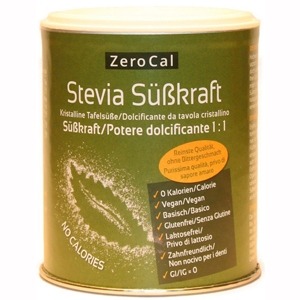Description
ZeroCal is a crystalline sugar substitute, which, as regards the degree of sweetening, taste and processing possibilities, has the same characteristics as traditional refined sugar.
ZeroCal is perfectly suitable for health conscious consumers, children and diabetics.
ZeroCal Stevia
The mixture is composed in such a way that 1 g of ZeroCal Stevia corresponds approximately to 1 g of traditional sugar. Hence, traditional sugar in food and drink can be replaced with ZeroCal Stevia in the ratio 1: 1.
By mixing erythritol with steviol glycosides it is possible to exploit the synergies existing between the two substances and at the same time remedy the respective deficiencies. In fact, pure erythritol boasts only 75% of the sweetening power of sugar and therefore requires the use of a larger quantity of traditional sugar. The same is true – albeit in reverse – for the exclusive use of steviol glycosides. Since the sweetening power of the latter is 350 to 400 times stronger than common cooking sugar, it is very difficult to fully replace the sugar with steviol glycosides.
Stevia
The Stevia rebaudiana plant is a plant species that belongs to the genus of stevie (stevia), which in turn are part of the composite family. This plant has already been used for centuries for its strong sweetening power. Originating from the north-eastern areas of Paraguay and the neighboring mountain areas of Brazil, stevia is cultivated for commercial purposes, for example also in Japan and Spain. In Japan, this sugar substitute has already captured more than 40% of the sweetener market. For 30 years, stevia has been used in many products and declared safe from a health point of view.
Advantages of Stevia rebaudiana:
- is a completely natural and not synthetic product
- is suitable for diabetics and does not raise blood sugar
- prevents tooth decay and is therefore not harmful to the teeth
- helps to dispose of toxic substances during digestion
- helps to heal wounds quickly by revitalizing skin cells
- does not contain calories
- pH stable
- the steviol glycoside remains stable up to 200 ° C
Production
A natural sweetener, the steviol glycoside, is extracted from the leaves of the Stevia rebaudiana plant. The dried leaves of the stevia are treated with water, then the dissolved substances are precipitated with salts and decoloured with special resins. The phases of desalination and crystallization from an alcoholic solution are then carried out. This last procedure is repeated until the steviol glycosides are sufficiently pure. The Stevia plant has numerous glycosides, but the main component is made up of a total of eight: stevioside, rebaudioside A, B, C, F, steviol bisodium, dulcoside A and rubusoside. Rebaudioside A has the best organoleptic characteristics of all four main glycosides (the sweetest, slightly bitter). The higher the Reb-A content, the better the quality of the steviol glycoside.
We only use steviol glycosides with a Reb-A content higher than 97%.EU authorization
June 2008: A UN committee of experts had certified that stevia poses no risk to human health. Subsequently, the first individual applications for authorization to use a sweetener additive consisting of stevia were approved in Switzerland.
March 2010: In Switzerland, stevia is authorized for individual products such as chocolate or iced tea. In addition, stevia is on sale in supermarkets.
December 2011: The sweetener steviol glycoside is authorized in the European Union under the code �E960� as a food additive.
Ingredients : Sweetener erythritol and steviol glycosides (rebaudioside A> 97%)
Sweetening power like sugarNutritional information: Per 100 g
Energy 0 kj – 0 kcal
Fat 0 g
of which saturates 0 g
Carbohydrates 99.74 g
of which sugars 0
of which sugar alcohols * 99.74
Protein 0 g
Salt 0 g* No effect on postprandial blood glucose, no net countable carbohydrates.





